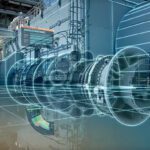Digital technology is everywhere today including in most power plants. Computer hardware and software are changing the way plants are operated and maintained. Many technology experts will tell you that advanced algorithms are better-suited to identify and predict equipment problems than even the most-skilled and longest-tenured plant operator, and they can usually point to real-world data to prove their point.
Technology Featured at Event
POWER-GEN International, a power industry trade show that event organizers claim is the largest in the world, was held December 4–6, 2018, in Orlando, Florida. POWER was a media partner for the event, had a booth on the show floor, and was one of the car-giveaway sponsors. Digital technology was front-and-center at the show.
On day one, Robert Yeager, president of Emerson’s Power and Water Solutions business, gave one of the keynote addresses. Emerson makes the Ovation distributed control system, which Yeager said automates 1.3 million MW of generating capacity around the world in coal, gas, nuclear, solar, hydro, and wind facilities. He said about half of all U.S. generating capacity utilizes the platform.
“Digital transformation can be the solution to your worries,” Yeager said. “It’s the key to the future. It will change the way we work.”
Yeager said there are three good reasons to embrace digital technology: reliability, knowledge transfer, and innovation. Furthermore, he said a digital power plant twin can positively affect each of those pieces.
The Digital Twin
POWER met with Yeager during the show for an exclusive interview. He was very excited about the future of digital twins and technological improvements his company is making to these systems. He said the problem with many digital twins on the market today is that they simply provide “a snapshot in time that rapidly becomes inaccurate. There’s a slow inevitable decline in its accuracy to the point where you’re probably better off not having anything.”
According to Yeager, the digital twin Emerson is working on—and has been for the past six years—will have about 10 million lines of code. It will have the same “DNA” as the digital control system running the physical power plant. He said the software tools used to create the real plant are also used to create the digital plant. It will be fully integrated, but separate. It will have a common database between the two that will update automatically, with real-time synchronization; as the plant’s control scheme changes, the digital twin’s control scheme will change too.
Having an advanced digital twin of that nature makes “time travel” possible, Yeager said. If a piece of control logic is not functioning as intended, an operator is able to alter the logic in the digital twin, fast forward time in the system, and see how the digital plant responds. If the desired outcome is observed, the change can be made in the real system, solving the control problem. However, if the logic change was found to have no effect or even worsen the situation, then the operator can go back and try again with this newfound knowledge. The operator could go so far as to trip the plant in the digital world without causing any adverse effects to the real unit. The process increases reliability, assists with knowledge transfer, and allows innovation.
“We already have 65 projects around the world that we’re working on,” Yeager said. “If you walk down to our test floor today, where we test all these systems, there’s quite a few that already have this integrated twin. But I believe that certainly in five to seven years, every project that we do—every project that we do—will have this.”
Somewhat surprisingly, it’s not something that can only be incorporated into new plants. “You don’t need to rip and replace everything,” Yeager said. “You may not know it, but for the last couple of decades, automation systems have been built on common IT technology. Common IT technology is a building block for digital transformation.”
Connected Power Plants
There’s another great opportunity to learn about the latest technological advancements designed to enhance power plant performance. POWER’s third annual Connected Plant Conference will convene in Charlotte, North Carolina, February 19–21, 2019. Companies like ABB, Siemens, AVEVA (now part of Schneider Electric), and many others are sponsoring the event, which will include sessions on getting value out of data, risk management, network architecture, asset optimization, wireless and drone technology, improving operations with digital systems, and much more.
Case studies presented by end-users from Duke Energy, Southern Company, Arizona Public Service, Nova Scotia Power, Tennessee Valley Authority, Wisconsin Public Service, American Electric Power, and others, along with experts from the Electric Power Research Institute and the National Energy Technology Laboratory, will offer real-world examples of how digital technology has been implemented at facilities across the country. It truly is an opportunity like no other to meet and network with leaders who have embraced change and are reaping the rewards.
For more information and to register for the event, visit connectedplantconference.com. I’ll be there, and I hope to see you there too. ■
—Aaron Larson is POWER’s executive editor.










